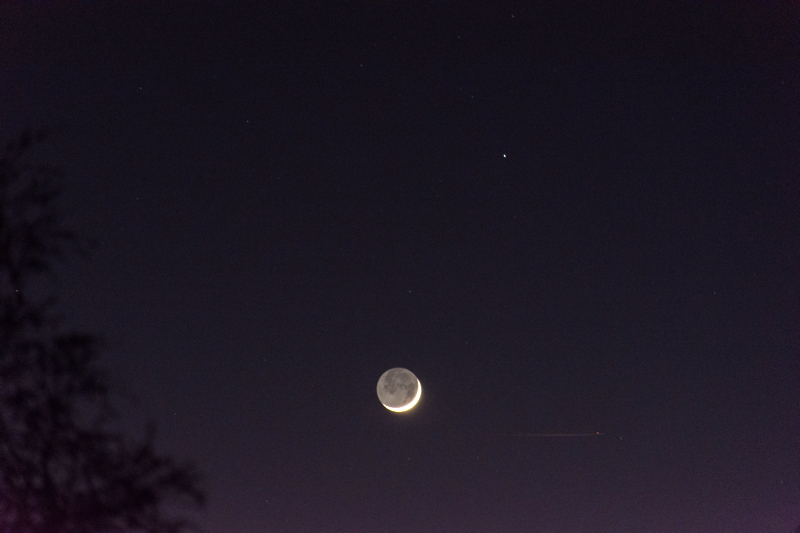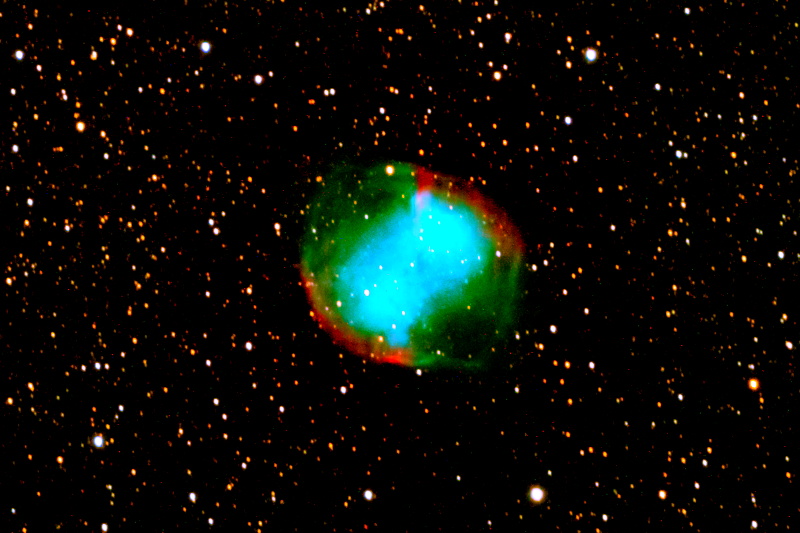Imaging: Crescent Moon, Earthshine, Dumbbell Nebula, Pleiades
Posted: 14 November 2015
Thursday, 12 November 2015, was a windy and partly cloudy day. The sky became mostly overcast as sunset approached. Friday was mostly clear during the day, but breezy.
|
Open: Friday, 13 November 2015, 1813 MST Temperature: 66°F |
Session: 880 Conditions: Clear, breezy |
A crescent Moon was nicely visible in the western sky from the observatory. This handheld D7200 DSLR photo is cropped from the full-frame version and taken at f/5.6, 1/30sec, ISO 400, FL 140mm:

This full-frame D7200 photo, f/5.6, 1/2sec, ISO 2500, FL 140mm, also handheld, shows the Earthshine and a star:

If you look closely at the above photo you will see a plane with a red light and its moonlit contrail to the right of the Moon.
This is a wider view, handheld, D7200, f/4.8, 1/4sec, ISO 3200, FL 50mm, showing Earthshine and some fading twilight:

1830 MST: after ending sky photography, I viewed the crescent Moon in the 8" LX200-ACF telescope at 83X. Earthshine was very nice through the telescope. Took this handheld photo, afocal 83X, using the iPhone 6s Plus:

1844 MST: slewed to M27 (Dumbbell Nebula) and began setting up to image it with the D7200 DSLR. Mounted the D7200 at prime focus + extension + off-axis guider. Did a focus test on the star Altair using a Bahtinov Mask. Slewed back to M27 and searched for a guide star; found one. 1906 MST: this is a 5 minute, guided, ISO 5000, exposure, cropped from the full-frame image:

1935 MST: after completing M27 imaging, added the focal reducer and slewed to M45 (Pleiades). Set the camera orientation for best framing of the Pleiades, then searched for a guide star. Unfortunately, I could not locate a good guide star that still provided good framing of the Pleiades. Decided I would try high ISO imaging this night. But first, did a focus test on the star Capella using the Bahtinov Mask. Then back to M45. This is a full-frame, unguided, 2 minute, ISO 25600, exposure, showing some nebulosity:

2017 MST: ended prime focus imaging. Wind was picking up. Did some handheld sky imaging. This is the Pleiades and Hyades star clusters, f/4, 1/2sec, ISO 12800, FL 27mm:

2041 MST: viewed M45, 83X. Then began closing up.
|
Close: Friday, 13 November 2015, 2051 MST Temperature: 60°F |
Session Length: 2h 38m Conditions: Clear, windy |
Comments are welcome using Email. If you are on Twitter you can use the button below to tweet this report to your followers. Thanks.
Cassiopeia Observatory Home Page
Copyright ©2015 Michael L. Weasner / mweasner@me.com
URL = http://www.weasner.com/co/Reports/2015/11/14/index.html
